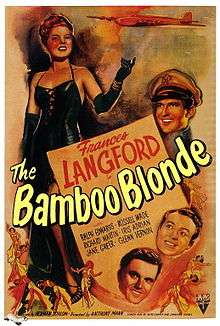The Bamboo Blonde
| The Bamboo Blonde | |
|---|---|
 Theatrical release poster | |
| Directed by | Anthony Mann |
| Produced by | Herman Schlom |
| Screenplay by |
Olive Cooper Lawrence Kimble |
| Based on |
the story "Chicago Lulu" by Wayne Whittaker |
| Starring |
Frances Langford Ralph Edwards Russel Wade |
| Music by | C. Bakaleinikoff |
| Cinematography | Frank Redman |
| Edited by | Les Millbrook |
Production company | |
| Distributed by | RKO Pictures |
Release dates |
|
Running time | 67 minutes |
| Country | United States |
| Language | English |
The Bamboo Blonde is a 1946 American war film directed by Anthony Mann based on an original story "Chicago Lulu" by Wayne Whittaker. Saddled with a low budget, it stars singer Frances Langford in the title role, Ralph Edwards (from TV's This Is Your Life) and bit player Russell Wade. As an RKO star, Langford was famous for her role in entertaining the troops in World War II, and the film featured a number of songs that her character sings at a nightclub.
Plot
Businessman Eddie Clark (Edwards) tells a reporter the story behind his conglomerate of products branded as the "Bamboo Blonde". During the Pacific War, Captain Patrick Ransom, Jr. (Wade), the pilot of a B-29 bomber is stood up by his fiancée Eileen Sawyer (Greer) on the way to meet his new crew at a New York nightclub, owned by Clark. Instead, he sees Louise Anderson (Langford), a beautiful blonde singer at the nightclub. Although engaged, he falls in love with the singer, but has to leave next day for action in the Pacific, joining an experienced bomber crew as their new pilot. The crew is reluctant to accept their new "skipper" and decide to dump him at the out-of-bounds nightclub, coming back later to find the Captain and the torch singer kissing.
In the Pacific, after realizing that a string of their bad luck has to be broken, Captain Ransom acquiesces to the crew painting the image of "Bamboo Blonde" on the nose of his bomber, as the crew members think that the striking blonde singer they had seen, is his girl. The "Bamboo Blonde" becomes famous when the B-29 sinks a Japanese battleship and shoots down numerous Japanese fighter aircraft. The armed forces decides to bring the "Bamboo Blonde" and its crew back home to sell war bonds across the country and Clark knows that he can exploit his singer's connection to the famous bomber. Back in New York, the Captain leaves his fiancée and seeks out Louise, who has also fallen in love with the pilot.
Cast
- Frances Langford as Louise Anderson
- Ralph Edwards as Eddie Clark
- Russell Wade as Patrick Ransom, Jr.
- Iris Adrian as Montana Jones
- Richard Martin as Jim Wilson
- Jane Greer as Eileen Sawyer
- Glen Vernon as Shorty Parker (as Glenn Vernon)
- Paul Harvey as Patrick Ransom, Sr.
- Regina Wallace as Mrs. Julie Ransom
- Jean Brooks as Marsha
- Tommy Noonan as Art Department (as Tom Noonan)
- Dorothy Vaughan as Mom
- Jason Robards, Sr. as American Officer
Production
In May 1943, RKO originally advertised that a countrywide series of contests would be used to find an "unknown" to portray The Bamboo Blonde in a future romantic comedy feature.[1] Anthony Mann, on only his 11th film as a director, is better known for later working with James Stewart on (primarily) western films like The Naked Spur (1953), film noirs and epics in his last years. This early film is typical of a period when Mann accepted any and all assignments in a variety of genres.
Music
The soundtrack included many big band pieces performed by Frances Langford.
- "I'm Good for Nothing but Love", written by Mort Greene and Lew Pollack, sung by Frances Langford
- "Dreaming out Loud", written by Mort Greene and Lew Pollack, sung by Frances Langford
- "Moonlight over the Islands", written by Mort Greene and Lew Pollack, sung by Frances Langford with chorus
- "Right Along about Evening", written by Mort Greene and Lew Pollack, sung by Frances Langford
- "Right Along about Evening", written by Mort Greene and Lew Pollack, sung by Frances Langford, Paul Harvey, Ralph Edwards, Iris Adrian and Regina Wallace
Notes
Scenes from The Bamboo Blonde later appeared in an excerpted form in Make Mine Laughs (1949), starring Joan Davis, Dennis Day and Ray Bolger. The new film was a kind of filmed vaudeville show, using old material from RKO films and some new filmed scenes.
Mainly due to its connection with Mann, the film was screened at the recent B Musicals Film Festival at Film Forum in New York City.[2]
References
Notes
- ↑ "'The Bamboo Blonde' on RKO Schedule." The New York Times, May 3, 1943. Retrieved: July 2, 2011.
- ↑ "B Musicals at Film Forum in New York City." filmforum.org, April 2011. Retrieved: July 1, 2011.
Bibliography
- Cooke, Mervyn. A History of Film Music. Cambridge, UK: Cambridge University Press, 2008. ISBN 978-0-521-01048-1.
- Dolan Edward F. Jr. Hollywood Goes to War. London: Bison Books, 1985. ISBN 0-86124-229-7.
- Evans, Alun. Brassey's Guide to War Films. Dulles, Virginia: Potomac Books, 2000. ISBN 1-57488-263-5.
- Harwick, Jack and Ed Schnepf. "A Viewer's Guide to Aviation Movies". The Making of the Great Aviation Films, General Aviation Series, Volume 2, 1989.